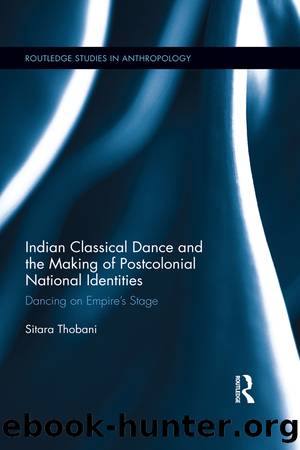Indian Classical Dance and the Making of Postcolonial National Identities by Sitara Thobani

Author:Sitara Thobani [Thobani, Sitara]
Language: eng
Format: epub
Tags: Social Science, Anthropology, General
ISBN: 9781315387338
Google: pCglDwAAQBAJ
Barnesnoble:
Goodreads: 31523309
Publisher: Routledge
Published: 2017-03-24T00:00:00+00:00
The colour of professionalism
The various points of contrast drawn between India/Indians and the West/Westerners I encountered relied rather unsurprisingly on â and thereby sustained once more â that persistent and stereotypical binary of the West as technical and the East as emotional. This opposition was apparent in the previous comment where the professional South Asian dancer suggested she would ask âsomeone who was not Indianâ (white, based on the context of the conversation) to substitute for her in teaching a workshop as âthose are the people that I know do it bestâ. This dichotomy was also reflected in the remarks of a Kathak teacher â particularly respected for being amongst the earliest pioneers of Indian classical dance in the UK and having trained several well-reputed dancers â during a performance in London:
In technique, Western students are quicker than I and other Indians ever were. The problem is in teaching abhinaya [narrative or acting dances]. Westerners are too reserved, you canât even teach them to smile properly. In India, people push each other over to get on the train and within ten minutes theyâre sharing food; in the UK, everyone sits with an iPod or book on the tube, no on looks up, they are so closed.
The suggestion here is that while Westerners may work hard, they cannot do good abhinaya for they are too closed emotionally and think rather than feel. Despite the ambiguity in this teacherâs statements â for it is never clarified where diasporic dancers may be located on this spectrum â the sentiments he shared were echoed by others who similarly celebrated the industrious tendencies of Western/white dancers. For example, a professional dancer based in London reflected in an interview that:
Itâs strange that as a [Northern European] dancer Iâve been able to make a living out of Indian classical dance. I think itâs partly to do with the fact that dancers with an Indian background see it as a mediated dance. They see it as something to link their background, cultural heritage and they donât see it as an art form, they donât take it as seriously. Whereas dancers from other backgrounds, they see it as an art form and they take it seriously. And also they have to do more research, you canât assume that itâs in my blood or I just know it because I grew up with it. You have to look for the answers, you have to do much more research.
Aside from this dancerâs reference to blood and the innate proclivity to Indian classical dance this is meant to represent, the suggestion that dancers of Indian backgrounds see the form as âmediatedâ due to the strength of its supposed cultural moorings operates on popular assumptions. Moreover, this assertion contributes to the idea that diasporic dancers may not have to work as hard as their white/Western counterparts for the greater cultural gap the latter are thought to have to bridge.
Later describing a group of non-Indian dancers with whom she worked, this dancer concluded that
Download
This site does not store any files on its server. We only index and link to content provided by other sites. Please contact the content providers to delete copyright contents if any and email us, we'll remove relevant links or contents immediately.
| Chakras | Gandhi |
| History | Rituals & Practice |
| Sacred Writings | Sutras |
| Theology |
Fingersmith by Sarah Waters(2486)
Kundalini by Gopi Krishna(2138)
Wheels of Life by Anodea Judith(2098)
Indian Mythology by Devdutt Pattanaik(1903)
The Bhagavad Gita by Bibek Debroy(1901)
The Yoga of Jesus: Understanding the Hidden Teachings of the Gospels by Paramahansa Yogananda(1806)
Autobiography of a Yogi (Complete Edition) by Yogananda Paramahansa(1778)
The Man from the Egg by Sudha Murty(1749)
The Book of Secrets: 112 Meditations to Discover the Mystery Within by Osho(1633)
Chakra Mantra Magick by Kadmon Baal(1618)
The Sparsholt Affair by Alan Hollinghurst(1548)
Sparks of Divinity by B. K. S. Iyengar(1496)
Avatar of Night by Tal Brooke(1492)
Gandhi by Ramachandra Guha(1488)
Karma-Yoga and Bhakti-Yoga by Swami Vivekananda(1470)
The Bhagavad Gita (Classics of Indian Spirituality) by Eknath Easwaran(1455)
The Spiritual Teaching of Ramana Maharshi by Ramana Maharshi(1407)
Hinduism: A Very Short Introduction (Very Short Introductions) by Knott Kim(1348)
Skanda Purana (Great Epics of India: Puranas Book 13) by Bibek Debroy & Dipavali Debroy(1342)
